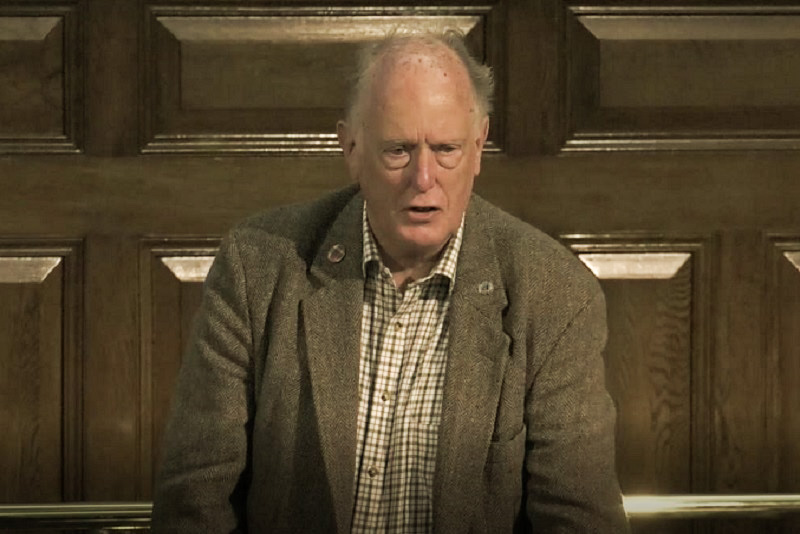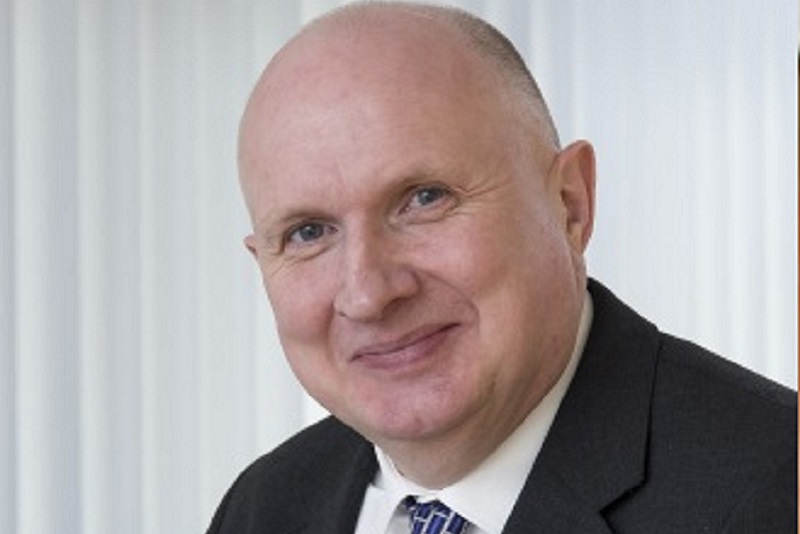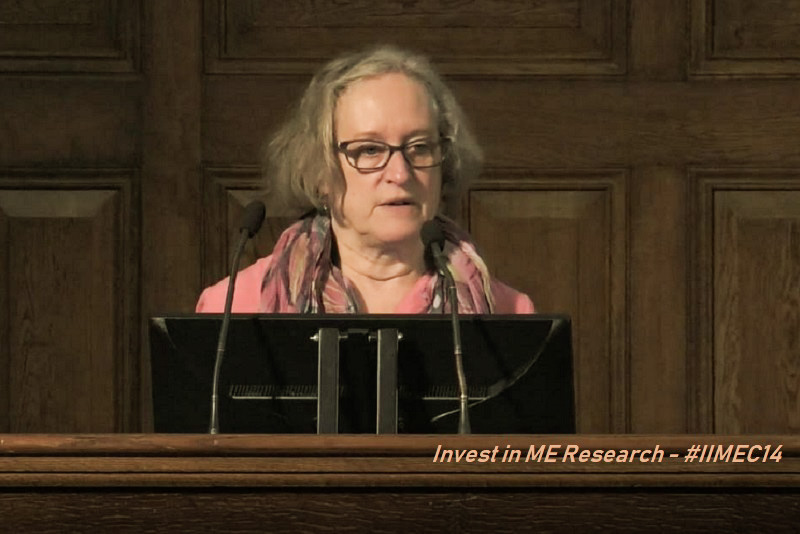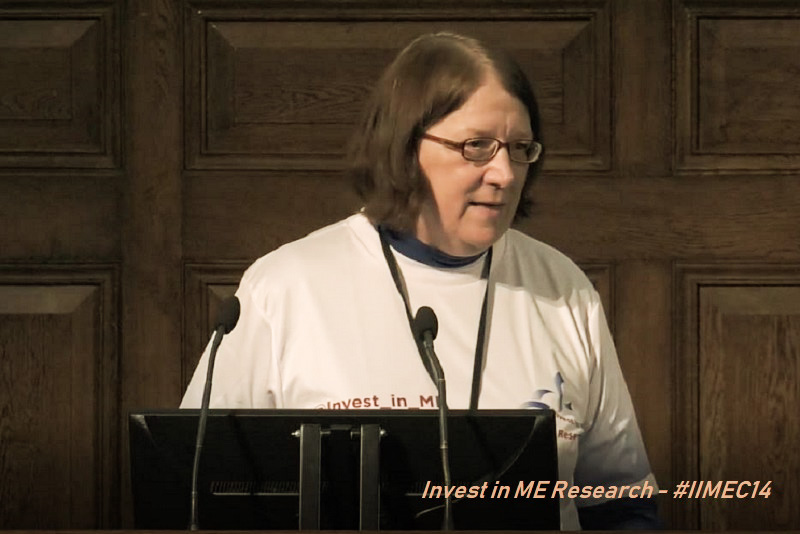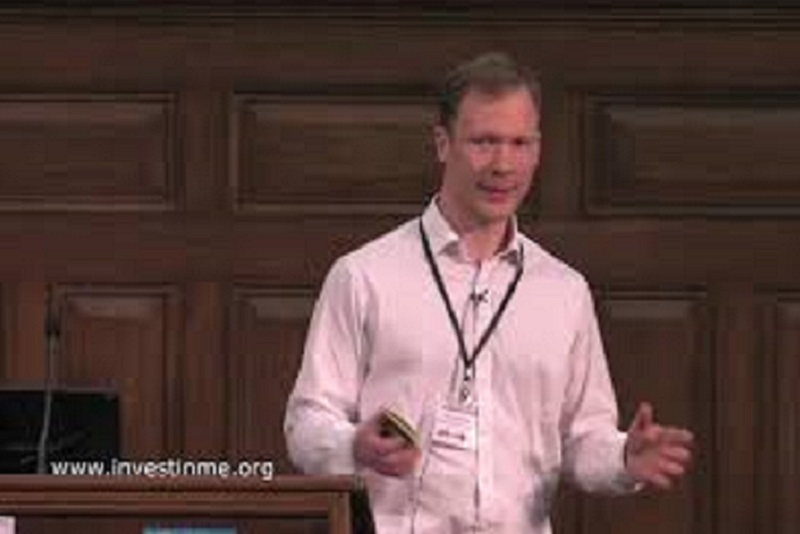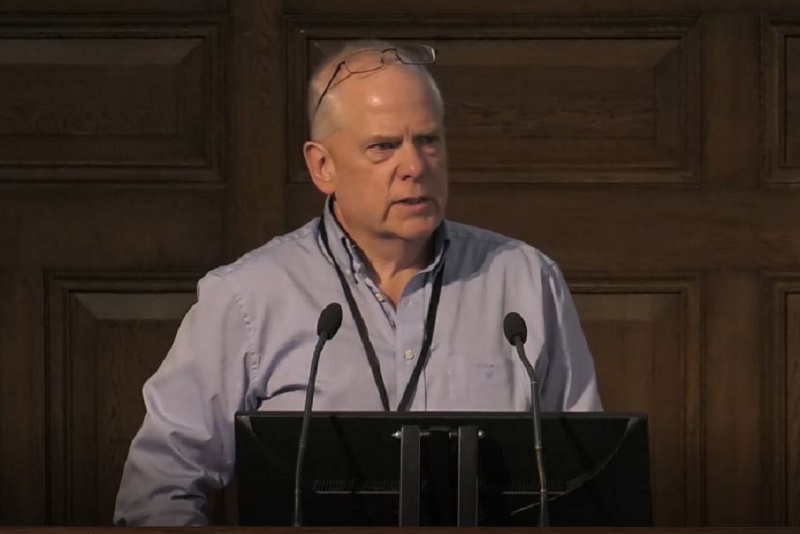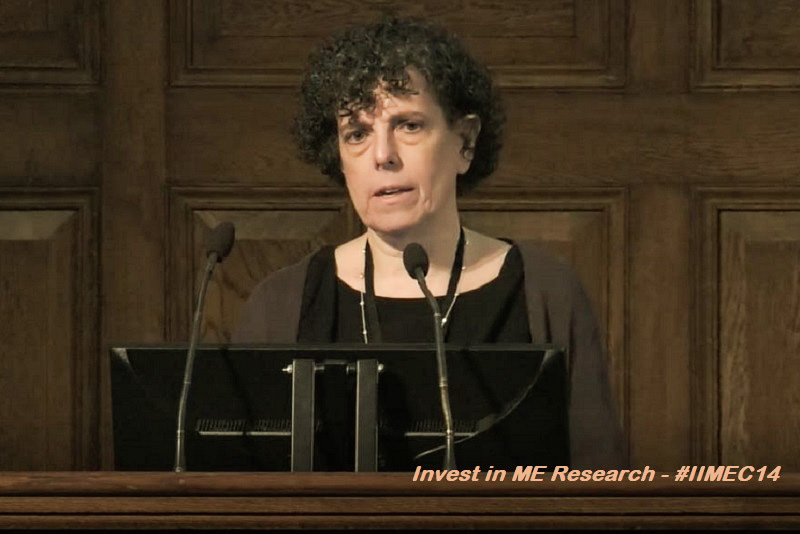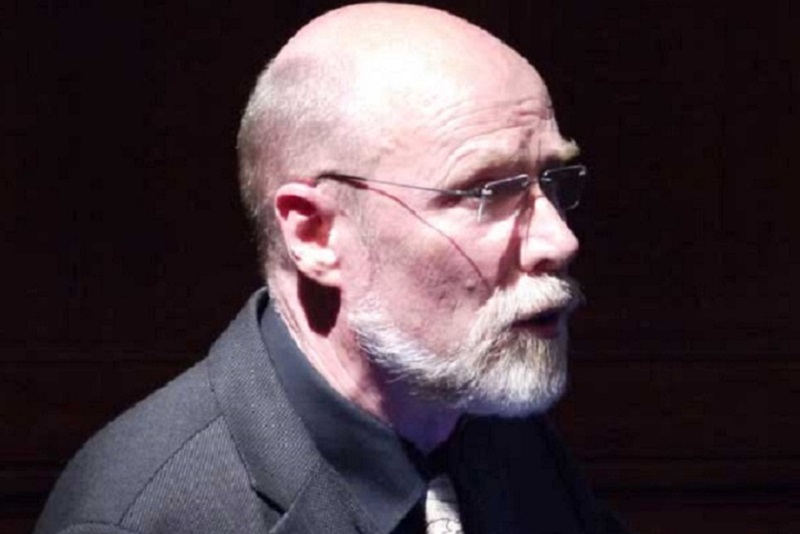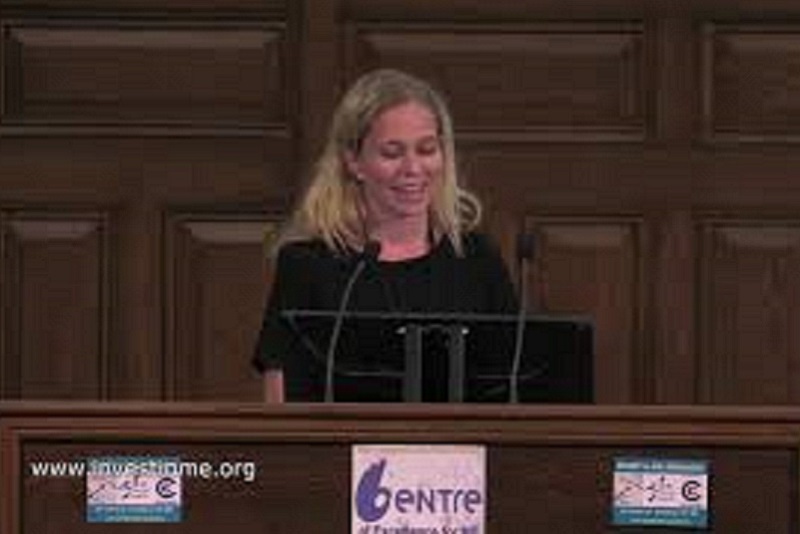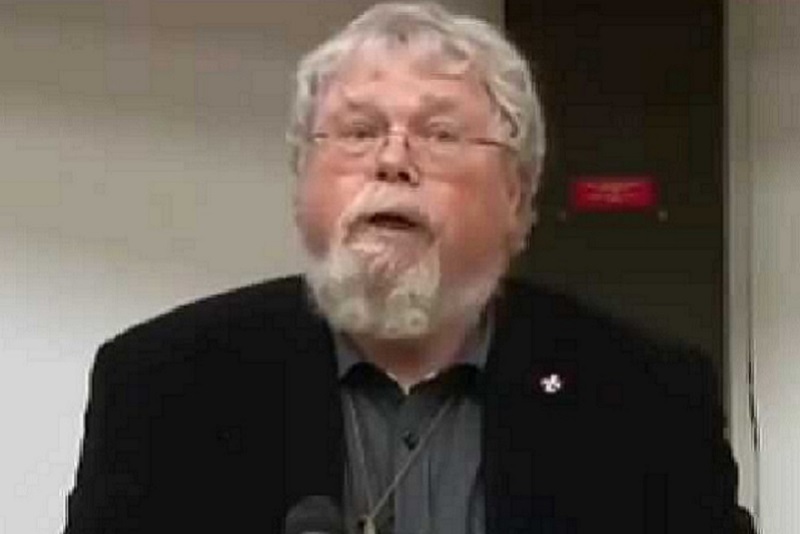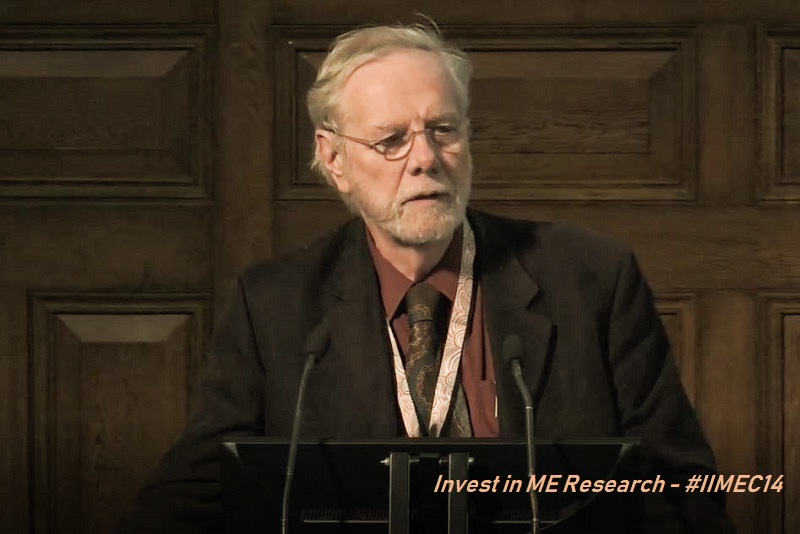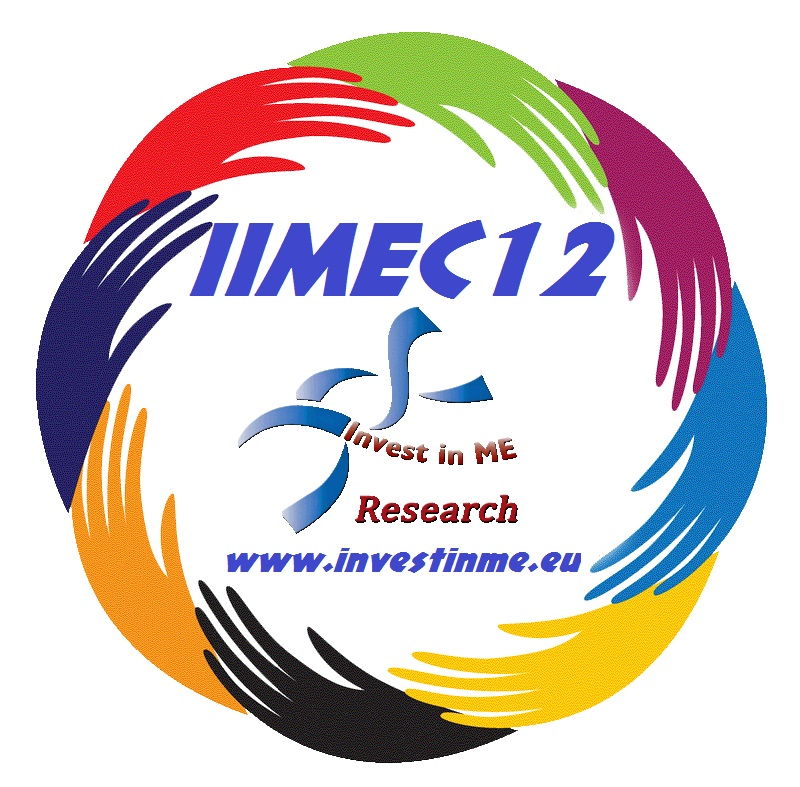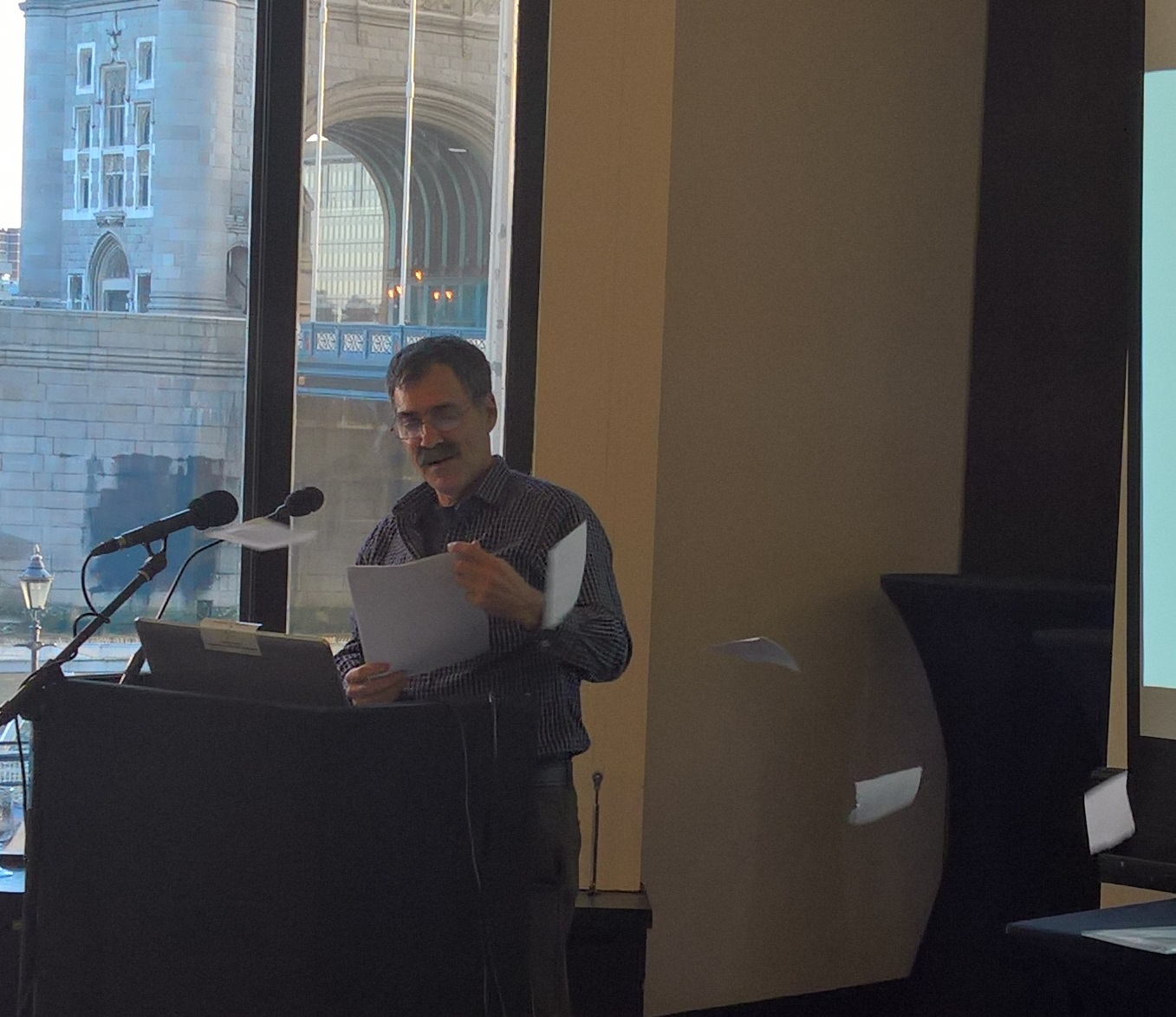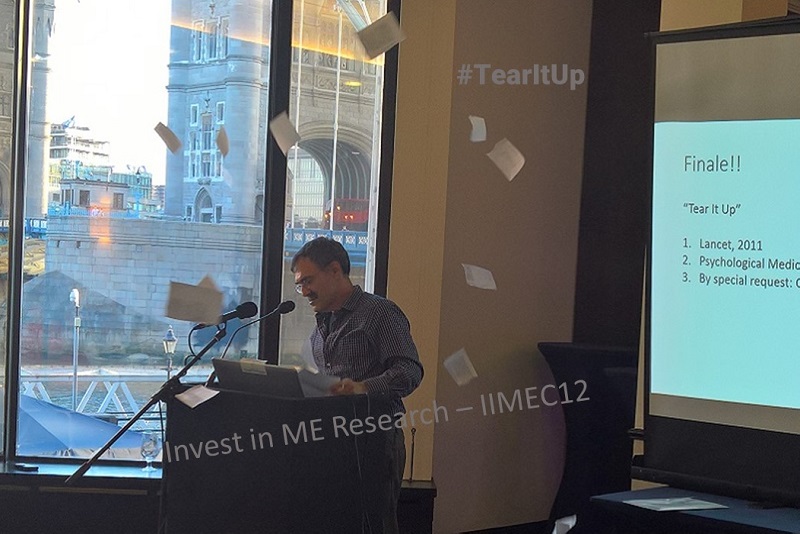
Invest in ME Research International ME Conference 2017
IIMEC12 - Centres of Excellence for ME

Click on sections below
IIMEC12 Conference Report
from Dr Rosamund Vallings MNZM, MBBS
Dr Rosamund Vallings attended the IIMEC12 International ME Conference in London and made this report of the proceedings
12th Invest in ME Research International ME Conference
CONFERENCE REPORT
by Dr Rosamund Vallings MB BS
2nd June, London Rosamund Vallings MB BS Invest in ME Research 2017
I was privileged to attend the 12th Invest in ME Research International conference on 2nd June in Westminster, London. This followed a 2 day colloquium where many of the top International ME/CFS researchers had gathered to discuss their work. At the conference there was a full day of presentations by a wide range of International speakers on a variety of associated topics.
The conference was opened by Dr Ian Gibson.
The first presentation was by Dr Ian Charles (leader of the Quadram Institute, Norwich, UK), who outlined the development of the UK Centre of Excellence for ME/CFS. He told us there are likely to be approximately 250,000 with ME/CFS in the UK, of which 25,000 are children and young people. Up to 84% may not yet be diagnosed. Possible causes were outlined, which included dysbiosis of the microbiota and possible auto-reactivity to commensal microbes. Norwich Research Park, with the interdisciplinary Quadram Institute of Food Health is Europe’s largest single-site concentration of research, and includes 3000 scientists and 14,000 students. There is a hospital on site. Research includes food science and also how the microbiome relates to the immune system and health. The study of genomics is increasingly important. Microbiome research is being addressed in many diseases. The Quadram Institute has a long term commitment and will be the UK/Europe hub for biomedical research into ME/CFS. A video was then shown of the enormous campus and how it will be developed to accommodate the associated research into ME/CFS. It will also include medical facilities.
Dr Vicki Whittemore (NIH, USA) is programme director of the National Institute of Neurological Disorders and Stroke (NINDS). The NIH (made up of 27 institutes and centres) seeks knowledge about the nature and behaviour of living systems. The NIH is committed to ME/CFS research, both intramurally and extramurally. A current study is looking at 40 patients, 20 controls and 20 recovered Lyme disease patients. An extensive analysis and bio-specimen collection is being undertaken. The NIH is also organising seminars for building education, clinical and research issues. There is also revitalisation of the trans-NIH ME/CFS working group. This will stimulate research to include: identification of research priorities, a common data-elements project with the CDC and fostering of international research and collaboration. Canada is already collaborating. Funding has been significantly increased to $8 million. Common data elements: there is need to standardise and harmonise, with development of a common language. Many working groups will be involved. Funding opportunity announcements include: Determining the aetiology and pathology of ME/CFS, identification of subtypes, long-term studies and outcome measures and potential treatment targets. A timeline for setting these up is within the next 3-6 months. Long-term goals were discussed including support of treatment trials and improvement in quality of life.
Professor Donald Staines (Griffith University, Qld, Australia) discussed their paper “Impaired calcium mobilization and dysregulation of transient receptor potential melastatin 3 (TRPM3) ion channels in Natural Killer (NK) cells from CFS/ME”. Their group were the first to identifyTRPM3 on NK cells. There is impaired calcium mobilization. They also have studied NK cells, and find function and expression significantly reduced. Calcium is an important intracellular cell-signalling messenger. Biochemistry and genetics are involved. Immunological research shows a significant reduction in NK cell lysis, characterised by immune dysfunction. Because of their decreased function in ME/CFS, NK cells are a useful model to study. Significant changes are also evident in the genetics of NK cells. SNPs may change the function. TRPM3 stood out as abnormal. Its actual role in intracellular calcium mobilization has yet to be determined. TRPM3 converts “threat” signals, and threats are managed by these channels. Calcium is the 2nd messenger in every system. Calcium is up to 1000 times higher outside the cell than inside. Receptors open pathways to do the work in the cell. TRPM3 is the predominant ion channel and its expression is down in ME/CFS. This is very important in glial cells in the brain. The calcium signals can be measured. Unstimulated CD56 bright CD16 dim/- NK cells showed significantly reduced TRPM3 receptors in ME/CFS compared to healthy controls. Pregnenolone Sulphate (preg-S) stimulated CD56 bright CD16 dim/- NK cells increased TRPM3 expression significantly in ME/CFS, but this was not associated with a significant increase in Ca2+ flux and NK cell lysis. Thapsigargin (TG) stimulated CD56 bright CD16 dim/- NK cells significantly increased NK cell lysis prior to preg-S stimulation in patients compared to controls. This may all provide evidence for their role in the pathomechanisms involving NK cell cytotoxity in ME/CFS. There are significant effects in this system. Manipulation of TRPM3 function may lead to therapeutic interventions.
Professor Nancy Klimas (Miami, Florida) – reported on their genetic signature study. She pointed out that genetic studies are expensive, and large numbers of patients are needed – as many as 30,000 to be finding significant differences, therefore much funding is needed. She is part of a very large team. She outlined the symptoms of the illness. Studies are being undertaken to determine diagnosis, genetic risk, explanation of the illness and prediction of therapy. The gene study is unique and a huge challenge. Is there a genetic signature which determines why one person recovers and another remains ill? Students are using social media to recruit participants, who are asked to donate data rather than dollars. Development of a registry can be done on line, finding out history, illness progression etc. Many answers may be found. Basic single nucleotide polymorphism (SNP) methods can be used. A SNP is a single mutation in a gene – we have thousands of these (maybe 10 million), which make us the individuals we are. The approach using genetic data and symptom questionnaires could be used to look at potential treatments, diagnostic tests etc. Targeted treatments could be developed and tailored. The main barrier is money. Brainstorming is a very useful approach, with aggressive partnerships and more student power. Developments over 18 months are already in progress. The smallest number of participants to discover one abnormal SNP association is about 800. She said we need the “help of the world” and this project needs to “go viral”.
Dr Jakob Theorell (Karolinska Institutet, Sweden) works focussing on the understanding of the mechanisms of disease in patients suffering from chronic immunodeficiency syndromes. As an example of his work he initially discussed a rare potentially fatal disease in babies - Familial hemophagocytic lymphohistiocytosis (FHL), a disorder in which the immune system produces too many activated T cells. He has been studying NK cells and cytotoxic T-cells in ME/CFS. SNPs keep us in balance. Cytotoxic lymphocytes, part of our immune memory, have been found in other studies to be dysfunctional in ME/CFS. Effector cells attach to target cells. Assays using whole blood lymphocytes can be used to detect the impairments. Variables could select patients from controls. Cytotoxic lymphocyte counts can be done as well as looking at cytotoxic proteins. In ME/CFS, NK cell “killing” is reported as reduced. His study was on 48 patients from 2 cohorts and matched controls. Consistent differences were not found between patients and controls in cytotoxic lymphocyte numbers, cytotoxic granule content, activation status, exocytotic capacity, target cell killing, cytokine production or reprogrammed NK cell expansions. He concluded therefore that NK function could not be used as a biomarker for ME/CFS. Adrenaline may be important and there may be down-regulation of adrenaline receptors, responsible for lymphocyte defects.
Professor Jo Cambridge/Fane Mensah (University College Hospital, London) – works in the area of B-cell depletion treatment (Rituximab) in rheumatoid arthritis. Rituximab only works in sero-positive patients, not sero-negative. After treatment there is a delayed return of B cells – memory cells having been left behind, leading to gradual repopulation of the B cells. The number of B cells returning is not related to relapse. Rituximab works if auto-immunity is present. It stops new B cells differentiating to plasma cells. It also stops the interaction of B cells with T cells. Relapse occurs when B cells start to mature. An aberrant immune response is occurring. There are 2 types of patients: responders and non-responders. Cell differences include: memory-1 marginal zone B cells associated with IgM, CD24 which has a role in B cell maturation. CD21 which decreases over time and correlates with disease duration. Marginal zone (MZ) B cells are a subset of peripheral B cells that with other cell types may be important in the induction of auto-immune disease. MZ B cells were discussed in relation to the antibody response to Epstein Barr Virus (EBV).: Phase 1 – IgM antibody recognizes carbohydrates, IgM paints the infected cell, then fixes c-lysis. In Phase 2 the proper immune response kicks in with innate B cells. These do not make many antibodies, are associated with auto-immunity and drive the auto-immune response. In EBV the IgM is activated. In ME/CFS the IgG EBV antibody may be lower. Carbohydrate is recognized and has effects. There is increased expression of CD24 on B cells. There is high retention of CD24 on B cells, but this is age dependent and is lost with increased age. The mitochondrial mass in B cells is lower in ME/CFS. Their conclusions were that B cell subsets can be used to test metabolic changes. Antibodies can be involved in ME/CFS, and is there perhaps a role of metabolic processing in ME/CFS?
Professor Simon Carding (Norwich, UK) presented his team of young researchers from the University of East Anglia, who are researching the gut virome. 1. Fiona Newberry discussed the differences between the healthy and unhealthy gut. She described how a viral infection could cause inflammation and change in the microbiome. There could then be bacterial leakage into the bloodstream with auto-immunity. 2. Ernie (Shen-Yuan Hsieh) had looked at faecal samples for viral isolation and viral DNA extraction and sequencing. The viral inflammation could lead to leaky gut. He was looking to see if the viruses isolated could influence and/or kill their bacterial hosts in the gut. 3. Fiona then had looked at sequencing the viruses and coding DNA, putting this on the computer leading to viral informantics. Viral genomes are not yet characterized, and are often very similar. 4. The next presentation looked at the differences in the microbiome in ME/CFS. There was reduced diversity in the gut. Gut leakiness may link with the immune system. IgM antibody is secreted into the gut to cope with the bacteria. This may affect gut permeability. It is possible to separate the IgA negative and IgA positive bacteria. 5. Katharine Seton had looked at the bacteria in the gut in relation to auto-immunity. The aim of all this work was to look at suppression of the immune response – possibly with drugs, to look at bacterial therapy (possibly faecal transplants) and to do a Rituximab clinical trial.
Associate Professor Mady Hornig ( Columbia University, NY, USA) discussed gut metabolome-immune disturbances in ME/CFS subsets. She firstly reviewed the metabolome and immune disturbances. She discussed the influences of genetic factors, epigenetic regulation and environmental exposures during pregnancy and later life. Infection and immune factors have been shown to be relevant in some brain disorders. Normal microbiota modulate brain development. There is often gastro-intestinal co-morbidity in brain conditions (e.g. Irritable bowel syndrome in ME/CFS). In ME/CFS there is less diversity of the microbiota. Toxins, bacteria and undigested foods can escape into the bloodstream. There has been a staged strategy for pathogen discovery in immune-related brain disorders. Many viruses and bacteria have been proposed as possibly associated with ME/CFS. Viruses are likely to activate immune signaling in the CNS. She discussed profiles of immune markers, mechanisms of fever production and development of POTS. Viruses entering the brain can be associated with circulating cytokines crossing the blood-brain barrier (BBB) and with sympathetic NS activity. Distinct plasma immune signatures in ME/CFS are present early on. IFNα changes with duration. Inter-cytokine networks also change with duration. They had also looked at the cerebro-spinal fluid (CSF). There were reduced levels of a number of cytokines. There was a difference in regression model of association of cytokines. Bacteria from the microbiome can cross the BBB to cause microglial effects. There may be an autoimmune basis. The metabolome can affect such things as intestinal motility. These are very complex systems: e.g. Microbiota→ Metabolome→ Brain axis There is a need to look at patients with and without IBS.
Professor Olav Mella (University of Bergen, Norway) – started by giving a review of their clinical studies focusing on the use of RituxME (rituximab) and CycloME (cyclophosphamide). Earlier studies indicated that B-lymphocyte depletion may result in symptom improvement in a subgroup of ME/CFS patients. A Phase 3 double-blind, placebo-controlled intervention study with rituximab is now underway and due to be unblinded in October 2017. In the earlier rituximab trials, responses were transient and as B cells returned there was likelihood of relapse. Maintenance treatment therefore seems likely to be needed. Maintenance of the drug increased the response. The study of severe patients had to be stopped because of difficulties in getting patients to hospital. There was often a lag time before response. Auto-antibodies are likely to be involved. This all gave rationale for further studies. There is a need to look at dosage, resultant quality of life and overall improvement. This led to the Phase 3 study. Money was raised for a national RituxME study. 152 patients are enrolled. Treatment is not to be used outside clinical trials. There are occasional serious side effects. The cyclophosphamide trial resulted from a positive response by 2 out of 3 breast cancer patients treated with the drug, who also had ME/CFS. The level of the dose is very different in non-cancer patients. This study will finish in July. So far there are some good responses. The drug induces an early menopause. A new study has been started with CycloME with slightly less frequent injections. They also want to do metabolite analysis on the serum, and also look at the effects of patient serum on metabolites. They are finding that normal cells behave differently in ME/CFS serum, than in controls. His conclusions were: ME/CFS is an immune system disease, with mitochondrial abnormalities and a lack of ATP. There are thus widespread symptoms from multiple systems, with compensation mechanisms. When improving, all symptoms appear to improve simultaneously. Their future depends on the outcome of the rituximab study, and the pursuit of cyclophosphamide intervention.
Dr Ingrid Rekeland (Bergen, Norway) discussed more of the Norwegian work on behalf of Prof Øystein Fluge, who was recovering from injury. She discussed the likely obstruction of metabolic pathways in ME/CFS. She raised the questions as to whether this is an immunological variance of an auto-immune disease, and what are the biological effector systems. She cited the fact that B vitamins are coenzymes in the pyruvate dehydrogenase (PDH) complex, and this is closely related to the TCA cycle and electron transport train. The amino acid pattern suggested functional impairment of pyruvate dehydrogenase, supported by increased mRNA expression of the inhibitory PDH kinases.
Professor Warren Tate (University of Otago, New Zealand) started by explaining how he, as a biochemist had come to be involved in ME/CFS research. His 14 year old daughter had developed the illness after EBV. He graphically likened the research to the piecing together of a jigsaw puzzle. He is researching a small number of patients employing the technique of Precision Medicine (many tests on a small number of patients). MicroRNAs control all our physiology, and their study reflects what is going on in the body. Data has been collected on the transcriptome and the proteome as well as plasma microRNAs and cytokines, with the aim of integrating the data to elucidate linkages between different classes of molecules, and to give insight into physiological changes. Functional connections were shown between 9 out of 10 upregulated genes when the transcriptome was examined. A number of biochemical pathways are modulated. There is phosphorylation of protein kinase R in a chronically activated immune system. The PKR ratio in lymphocytes is elevated in ME/CFS and this has promise for further research. A small 10 patient study focusing on exercise intolerance and biochemical changes is also underway. Studies will be extended to include mitochondrial function and epigenetic changes in the DNA, particularly in relation to factors perpetuating the illness. The idea was discussed of the potential value of studying one patient long-term with regular (say monthly) analyses of many biochemical and immune parameters. This would be particularly important to see what was occurring during relapses and remissions.
Professor Ron Davis (Stanford, California, USA) also has pioneered his ME/CFS research as a result of having a severely ill son. He says this is no doubt a molecular disease, and there have been many molecular breakthroughs. New technology is developing fast. The aims should be to look at the mechanism of the disease, a diagnostic tool and then treatment. A biomarker needs to be inexpensive. And there is opportunity to develop molecular therapies. There is always difficulty with funding. He wants to develop new technologies which will reduce health costs. He encourages development of precision medicine approaches to understand and treat disease. He showed a flow chart to enhance understanding of the way the underlying mechanisms link together:
Genome sequencing can be done as it is less costly. His team is using a Big-Data approach: 20 severely ill patients, 10 controls and 8 families (including unaffected members who are ideal controls). The overall number of controls is reduced as each analysis for them costs as much as for the patients. A very long list of factors which are being measured was shown. Various results and ongoing studies, innovations and potential studies were presented: 1. Cell free DNA quantification of 20 SIPs samples and 10 controls – 2 out of the very severe patients showed up very high levels. 2. Multiplex viral sequencing in clinical samples with analyses of viruses. No viruses were detected in most ME/CFS patients. Healthy controls had more viruses than the patients. 3. Search for new pathogens – This was complex analysis but no new pathogens were found. 2 TT viruses were found, but controls had more than the patients. 4. Mitochondrial DNA in the severely ill – the same as in healthy controls 5. Cytokine levels track with phenotype severity – results will be on the Open Medicine Foundation website. 6. Disrupted metabolomics – here there is great complexity. There are some deficits and some surplus. 193 metabolites were examined. This relates to the TCA cycle. There was not the same result for all patients. Results were different to those found by Naviaux. 7. Lactate, glucose, sodium and potassium can all be measured using a sweat band, but this is expensive and a small inexpensive chip has been designed by Ron Davis. 8. The power of induced pluripotent stem cells – can be produced from blood for an infinite supply of various cell types. 9. Can use CRISPR genome editing technology. 10. A diagnostic test is needed. A nano-needle biosensor can be used to detect cells and molecules via electric signals. Adding sodium chloride gives a clearer signal. But results do need to be tested against other diseases. A simple silicon chip may be developed and cheaper to use. Maybe only 1c – a circuit on a chip for cell sorting, but a software programme would be needed for interpretation. 11. Mixing of healthy cells with healthy serum – normal. Mixing of ME/CFS cells with healthy serum – positive results. Mixing of healthy cells with ME/CFS serum – mild reaction from normal. 12. Magnetic levitation device – separates cells and can potentially identify ME/CFS patients. The important thing now is to share analyses with other researchers. Finally he discussed the fact that patients may get benefit from side effects from drugs used in other illnesses. For example, Suramin, an old drug discovered in 1916, is used in Africa to treat sleeping sickness. It shuts down the serogenic receptor, and works by inhibiting the signaling function of adenosine triphosphate (ATP). It is being trialled for use in autism .It is also possible it may help in ME/CFS. One dose only, administered IV may be needed. But the drug is not now easily available.
The conference concluded with a question and answer session and comments from Dr Ian Gibson about how far and excitingly the research has advanced. Invest in ME Research were thanked for the enormous amount of effort put in to organizing this event.
I must thank both Invest in ME Research and ANZMES for their support in helping me to attend this conference.
Rosamund Vallings MNZM, MBBS
Auckland, NZConference Presentations from IIMEC12
7th International Biomedical Research into ME Colloquium 2017
Invest in ME Research organised and hosted the Biomedical Research into ME Colloquium number 7 on 31st May - 1st June 2017.
Over seventy researchers from fourteen countries were invited to the two-day meeting.
This Colloqiuim was also opened by Dr Vicky Whittemore from NIH and Dr Elizabeth R. Under from CDC.
The collaborative atmosphere and planned cooperation resulting from the Colloquium will
help further progress research and ultimately help patients.
Our aim is to maintain this collaborative atmosphere where researchers can create new understanding about this disease and form new projects.
Use this link to go to the BRMEC Colloquium page.
Use this link to go to the BRMEC Colloquium page.
Our Sponsors for IIMEC12
IIMEC12 SPONSORS
Norges ME Forening - IIMEC12 Sponsor

Invest in ME Research are very proud to announce that EMEA Norway member
Norges ME Forening (NMEF) is supporting IiMER with a donation to the IIMEC12 conference.
NMEF Website"Last year Norges ME Forening sponsored the IIMEC11 conference by making a donation to the costs.
NMEF have always been supportive of IiMER and the conferences and we regularly welcome back so many Norwegian friends every year to London.
We would like to express our great thanks to NMEF for again helping IiMER in this way.Invest in ME Research continue to be impressed and amazed at the the continuing efforts that NMEF make in changing the way that ME is perceived and treated and the benefits that their work brings to the lives of people with ME and their families - not just in Norway but around the world.
NMEF lead by example. The results of their work - in improving education about ME, in fighting for patients' rights, in countering false information and flawed research about ME - has been an inspiration for many.
NMEF is at the centre of European collaboration and IiMER can always look for good advice and information from our Norwegian colleagues.Recently the charity hosted a visit by the research team from Haukeland University hospital in Bergen to the UK Centre of Excellence forming in Norwich Research Park. This amazing team has achieved so much with relatively few resources. Yet their achievements resonate across the world.
In the same way one can look to NMEF for astounding achievement, for strong and reliable support for biomedical research and for a real understanding of what this disease really is and how it affects patients, families and friends.Again this year IiMER looks forward to welcoming many Norwegian friends, patients and carers to IIMEC12 conference and it is one of the highlights of the conference events.
Already we have invited and received acceptances from nine Norwegian researchers to participate and/or present at our 7th Biomedical Research into ME Colloquium (#BRMEC7) in London - a two day closed researchers meeting that precedes the #IIMEC12 public conference.
Thank you Norges ME Forening - from all at IiMER and from all our supporters - for all that you have continue to do to help people with ME"
RME Sverige - IIMEC12 Sponsor
Invest in ME Research are very proud to announce that EMEA Sweden member Riksföreningen för ME-patienter (RME) has made a kind donation to IiMER to help with the conference costs.
IiMER chairman Kathleen McCall writes -

""On behalf of Invest in ME Research, I would like to thank the board of RME for the donation, which was given to Invest in ME
Research to help with costs of the IIMEC12 London Conference organised by the charity.
Again, RME Sverige has donated to Invest ME Research to assist us in covering the costs of the Conference.
As we mentioned last year this support not only helps Invest in ME Research with the costs of these events
but also illustrates the continuing cooperation with RME as we jointly, within the European ME Alliance, develop a strategy of
collaborative biomedical research into ME.
With our Swedish friends, we have been able to facilitate new research collaborations between Swedish
and UK researchers and form a European ME Research Group of researchers who cooperate - all for the betterment of science
and the future for ME patients. And thanks to support from our Swedish friends and colleagues we are able to
announce new input this year to the Colloquium/Conference events from Karolinska Institutet.
Like RME, Invest in ME Research seek to have high-quality
biomedical research applied to ME and this cooperation assists with that objective.
We have had RME joining us at our BRMEC5/BRMEC6 Colloquiums in the last years and again this year we continue to
cooperate as we develop further plans.
This all bolsters the ongoing development of the European ME Research Group, which develops European research into ME.
Again, this year IiMER looks forward to welcoming many Swedish friends, patients and carers to IIMEC12 conference and
it is one of the highlights of the conference events.
We have so far invited seven Swedish researchers to participate and/or present at our seventh Biomedical Research
into ME Colloquium (BRMEC7) and twelfth International ME Conference.
The donation will be used to cover some of these costs.
Thank you again so much for your support for Invest in ME Research" Riksföreningen för ME-patienter (RME) Website
IMET - IIMEC12 Sponsor
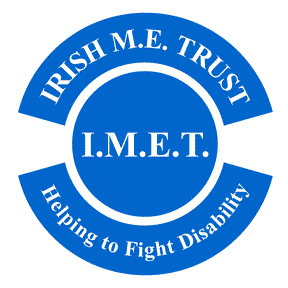
Irish ME Trust
Invest in ME Research are very proud to announce that EMEA Ireland member IMET (Irish ME Trust) has again agreed to sponsor a speaker at
the annual IIMEC* conference - IIMEC12 on 2rd June 2017.
This is the twelfth year that IMET have supported IiMER in this way.
IiMER chairman Kathleen McCall writes - "For yet another year we would like to express our thanks to IMET for again helping IiMER in this way. Twelve years of support given by IMET to IIMER and which has enabled IIMER to continue to organise a platform of international biomedical research into ME which demonstrates to researchers, healthcare staff, the media and politicians that real progress in discovering the cause(s) of ME can be made with the proper direction being given, and appropriate funding.
IMET continue to be at the heart of European collaboration and
are not only good friends but also have been consistent in all their work for ME patients and their families.
Thank you IMET - from all at IiMER and all our supporters - for all that you have done andare doing to support research into ME and to help
people with ME"
IIMEC12 Pre-Conference Dinner Presentation
David TullerUSA
IIMEC12 Opening IIMEC12
Dr Ian GibsonFormer Dean of Biological Sciences, UEA
Dr Ian Gibson was the former Labour MP for Norwich North. Dr Gibson worked at University of East Anglia for 32 years,
became Dean of the School of Biological Sciences at UEA in 1991
and was head of a cancer research team and set up the Francesca Gunn Leukaemia Laboratory at UEA.
In 2011 Dr Gibson received an honorary doctorate of civil law from UEA.
A scientist, politician and academic - Dr.Ian Gibson was uniquely qualified to comment on how science and politics have become intertwined.
Other Links
-
References
Keynote Speech - A Centre of Excellence for ME
Professor Ian Charles
Professor Ian Charles has over 30 years’ experience in academic and commercial research.
His academic career has included being a founding member of The Wolfson Institute for BioMedical Research at University College London, one the UK’s first institutes of translational medicine.
He has also worked in the pharmaceutical industry at Glaxo Wellcome, and founded biotech companies in the area of infectious disease, including Arrow Therapeutics,
sold to AstraZeneca in 2007, and Auspherix, a venture capital backed company founded in 2013.
His research interests are in the area of infectious diseases, the microbiome, and its impact on health and wellbeing.
He is particularly interested in harnessing ‘omics technologies to understand how microbes evolve, spread, survive and compete in the food chain to reduce foodborne illness and
to counter antimicrobial resistance.
Prior to becoming the founding Director of the Quadram Institute he was Director of the ithree institute, University of Technology, Sydney, Australia.
Keynote Speech - NIH Research into ME
Dr Vicky WhittemoreProgram Director in the National Institute of Neurological Disorders and Stroke at the National Institutes of Health in the United States.
Dr. Whittemore is a Program Director in the Synapses, Channels and Neural Circuits Cluster. Her interest is in understanding the underlying mechanisms of the epilepsies including the study of genetic and animal models of the epilepsies.
The major goal is to identify effective treatments for the epilepsies and to develop preventions. Dr. Whittemore received a Ph.D. in anatomy from the University of Minnesota, followed by post-doctoral work at the University of California, Irvine, and a Fogarty Fellowship at the Karolinska Institute in Stockholm, Sweden.
She was on the faculty of the University of Miami School of Medicine in The Miami Project to Cure Paralysis prior to working with several non-profit organizations including the Tuberous Sclerosis Alliance, Genetic Alliance, Citizens United for Research in Epilepsy (CURE), and the National Coalition for Health Professional Education in Genetics (NCHPEG).
She also completed a four-year term on the National Advisory Neurological Disorders and Stroke Council.
Dr. Whittemore oversees a grant portfolio that includes basic, translational and clinical studies on epilepsy. These include grants on sudden unexpected death in epilepsy (SUDEP), the genetic epilepsies, and seizure localization studies. In addition, she oversees a grant portfolio on myalgic encephalomyelitis/chronic fatigue syndrome (ME/CFS) and fatigue. Her additional interests are in research on global health issues, stigma, and co-morbidities.
-
References
Transient receptor potential ion channels in the aetiology and pathomechanism of CFS/ME
Professor Don StainesThe National Centre for Neuroimmunology and Emerging Diseases (NCNED), Griffiths University, Australia
Professor Staines has been a public health physician at Gold Coast Population Health Unit.
He has worked in health services management and public health practice in Australia and overseas.
His interests include collaborative health initiatives with other countries as well as cross-disciplinary initiatives within health. Communicable diseases as well as post infectious fatigue syndromes are his main research interests.
A keen supporter of the Griffith University Medical School, he enjoys teaching and other opportunities to promote awareness of public health in the medical curriculum. He is now Co-Director at The National Centre for Neuroimmunology and Emerging Diseases (NCNED), Griffiths University in Australia
Integrative Medicine Approach to Treatment of ME
Professor Nancy KlimasDirector, Institute for Neuro Immune Medicine, Nova Southeastern University
Director, Clinical Immunology Research, Miami VAMC
Professor of Medicine, Department of Clinical Immunology, College of Osteopathic Medicine, Nova Southeastern University
Chair, Department of Clinical Immunology, College of Osteopathic Medicine, Nova Southeastern University
Professor Emerita, University of Miami, School of Medicine
Nancy Klimas, MD, has more than 30 years of professional experience and has achieved international recognition for her research and clinical efforts in multi-symptom disorders, Myalgic Encephalomyelitis/Chronic Fatigue Syndrome (ME/CFS), Gulf War Illness (GWI), Fibromyalgia, and other Neuro Immune Disorders. She is immediate past president of the International Association for CFS and ME (IACFS/ME), a professional organization of clinicians and investigators, and is also a member of the VA Research Advisory Committee for GWI, the NIH P2P CFS Committee, and the Institute of Medicine ME/CFS Review Panel. Dr. Klimas has advised three Secretaries of Health and Human Services, including Kathleen Sabelius, during her repeated service on the Health and Human Services CFS Advisory Committee. Dr. Klimas has been featured on Good Morning America, in USA Today and the New York Times.
.-
References
Studies of NK cells and cytotoxic T-cells in ME-patients from one Swedish and one Norwegian cohort
Dr Jakob TheorellKarolinska University, Stockholm, Sweden
Dr Jakob Theorell, Stockholm, Sweden
.
-
References
Immunoregulation in Patients with ME
Dr Jo CambridgeUCL, London, UK
Dr Jo Cambridge, UCL, UK
.
-
References
Professor Simon Carding
Upon completing postgraduate work at the Medical Research Council’s Clinical Research Centre in Harrow, Professor Carding “emigrated” to the USA to take up a postdoctoral position at New York University School of Medicine, and then at Yale University as a Howard Hughes Fellow in the Immunobiology Group at Yale University with Profs Kim Bottomly and Charlie Janeway Jr. While at Yale an interest in gamma-delta (γδ) T cells was acquired working closely with Adrian Hayday on molecular genetics and then with Prof. Peter Doherty to establish their role in (viral) infectious disease.
He left Yale after five years to take up a faculty position at the University of Pennsylvania in Philadelphia where he developed a research interest in mucosal and GI-tract immunology, performing studies in germfree mice with Prof John Cebra that helped establish the role of gut microbes in the aetiology of inflammatory bowel disease (IBD).
After 15 years in the USA, he returned to the UK to take up the Chair in Molecular Immunology at the University of Leeds where he established a new research programme on commensal gut bacteria and Bacteroides genetics leading to the development of a Bacteroides drug delivery platform that is being used for developing new interventions for IBD and for mucosal vaccination.
In 2008 he was recruited by UEA and IFR to develop a gut research programme, taking up the Chair of Mucosal Immunology at UEA-MED and the position of head of the Gut Biology Research Programme at IFR, which later became part of the Gut Health and Food Safety (GHFS) Programme.
GHFS research covers a broad area of gut biology including epithelial cell physiology, mucus and glycobiology, mucosal immunology, commensal microbiology, foodborne bacterial pathogens, and mathematical modelling and bioinformatics. The success of this programme has led to the establishment of the Gut Microbes and Health research programme that is integral to the research agenda of The Quadram Institute.
-
References
Assoc.Professor Mady Hornig
Mady Hornig, MA, MD did her undergraduate studies as a College Scholar at Cornell, received an MA in Psychology from The New School for Social Research and an MD from The Medical College of Pennsylvania and completed her residency in psychiatry at The Medical Center Hospital of Vermont and an NIMH/NRSA Neuropsychopharmacology Fellowship at the University of Pennsylvania. Her research leverages large epidemiologic cohorts, novel bench science and animal model studies to determine how microbial, immune and toxic exposures impact upon the brain across the life course, resulting in disorders such as autism, attention-deficit/hyperactivity disorder (ADHD), Pediatric Autoimmune Neuropsychiatric Disorders Associated with Streptococcal infection (PANDAS), mood disorders, schizophrenia, myalgic encephalomyelitis/chronic fatigue syndrome (ME/CFS) and age-related cognitive deficits.
Dr. Hornig is internationally known for her work in the growing research arena exploring the mechanisms of gut-immune-brain axis functioning, seeking clues to both the understanding of the roots of dysfunction as well as uncovering pathways that strengthen individual resiliency. She has a keen interest in how diet, exercise and environmental factors affect each individual’s intestinal bacteria – the so-called gut microbiome – which then influences brain function through alterations in blood-borne molecules.
She has identified naturally-occurring substances that appear to strengthen resistance to certain disease states affecting the brain, and is pursuing these as candidates for prevention and intervention in ME/CFS and autism. She uses immune profiling, metabolomic, proteomic, epigenetic and microbiome approaches to identify prenatal and birth biomarkers for brain disorders in large prospective studies in Scandinavia as well as the US. She is also applying these approaches to uncover markers of disturbed immunity and metabolism correlating with the severe clinical deficits that underlie ME/CFS, work launched with support from the Hutchins Family Foundation/Chronic Fatigue Initiative, the National Institutes of Health and the crowd-funding initiative, The Microbe Discovery Project. Perhaps most exciting is that new ME/CFS subsets that appear to have different triggers and may respond differentially to treatment are now being identified through her work.
Dr. Hornig’s approach is enriched by her unusual combination of decades of experience as a clinical researcher, her acumen in defining novel neuropharmacological and nutritional approaches for brain disorders and her ability to carefully tease out factors that enhance resiliency to disease.
In 2004, Dr. Hornig presented to the Institute of Medicine Immunization Safety Review Committee and testified twice before congressional subcommittees regarding the role of infections and toxins in autism pathogenesis and has lectured on ME/CFS throughout the world. She has over 120 peer-reviewed publications, has edited several books, and has received many academic awards. Her work has been featured by the New York Times, the Los Angeles Times, The Washington Post, The Wall Street Journal, The Atlantic, Discover Magazine, Nature Medicine, Science, Wired, the Huffington Post, O Magazine, CBS News, and This Week in Virology.
-
References
Professor Olav Mella
Professor. Olav Mella
Professor. Olav Mella of Haukeland University Hospital in Bergen, Norway began his investigation of Rituximab’s effects on CFS after treating several Hodgkin’s Lymphoma patients who had long standing cases of CFS prior to developing cancer.
Professor Mella has performed clinical trials to test the benefit of B-cell depletion therapy using Rituximab in ME/CFS patients.
Professor Mella and Dr Fluge have published a paper "Benefit from B-Lymphocyte Depletion Using the Anti-CD20 Antibody Rituximab in Chronic Fatigue Syndrome. A Double-Blind and Placebo-Controlled Study"
Dr Ingrid Rekeland
Dr Ingrid Rekeland - Medical doctor, Haukeland University Hospital · Department of Oncology and Medical Physics
Professor Warren Tate
Professor Warren Tate
Last Update 10/08/2019



